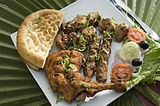Kheer/ja: Difference between revisions
Created page with "{{Navboxes|list1 = {{Bangladeshi dishes/ja}} {{Indian Dishes/ja}} {{Pakistani dishes/ja}} {{Puddings/ja}} {{Rice pudding/ja}} }} {{portalbar|Food}}" |
Created page with "==関連項目== * ポリッジ * フィルニ – 粉米または米粉を牛乳で煮て冷やして食べるデザート * シール・ベレンジュ – ペルシャのライスプディング * ドゥードゥパック – グジャラートのライスプディング * シェマイ – ベンガルのヴァーミセリプディング * シール・クルマ – ペ..." Tags: Mobile edit Mobile web edit |
||
| Line 59: | Line 59: | ||
</div> | </div> | ||
==関連項目== | |||
* [[Porridge/ja|ポリッジ]] | |||
* [[Porridge]] | * [[Phirni/ja|フィルニ]] – 粉米または米粉を牛乳で煮て冷やして食べるデザート | ||
* [[Phirni]] – | * [[Shir Berenj/ja|シール・ベレンジュ]] – ペルシャのライスプディング | ||
* [[Shir Berenj]] – | * [[Doodhpak/ja|ドゥードゥパック]] – グジャラートのライスプディング | ||
* [[Doodhpak]] – | * [[Shemai/ja|シェマイ]] – ベンガルのヴァーミセリプディング | ||
* [[Shemai]] – | * [[Sheer khurma/ja|シール・クルマ]] – ペルシャのヴァーミセリプディング | ||
* [[Sheer khurma]] – | |||
{{Navboxes|list1 = | {{Navboxes|list1 = | ||
Revision as of 14:10, 31 July 2025
| Kheer/ja | |
|---|---|
Kheer, khir or payasam is a pudding or porridge (specifically rice pudding) popular in the Indian subcontinent, usually made by boiling milk, sugar or jaggery, and rice. It can be additionally flavoured with dried fruits, nuts, cardamom and saffron. Instead of rice, it may contain cracked wheat, vermicelli (sevai), sago or tapioca (sabudana).
In Northern India, it is made in various ways. The most popular versions are the ones made with rice and vermicelli (semiya).
Etymology
The word kheer is derived from the Sanskrit word kshira (क्षीर), which means milk or a milk-based dish. Kheer is also the archaic name for sweet rice pudding. The word payasam used in South India for kheer originates from the Sanskrit term pāyasa (पायस), which means "milk" or a dish made from milk. This term evolved into various regional languages, including Malayalam (പായസം, pāyasaṁ), Telugu (పాయసం, pāyasaṁ), and Tamil (பாயசம், pāyacam).
Origin
It is said to have originated initially in South India thousands of years ago. The story is titled "The Legend of Chessboard" in Kerala, an old sage in the form of Krishna challenged the king of Ambalapuzha (chess enthusiasts) to play chess. To motivate the sage, the king offered anything that the sage would name. The sage modestly asked just for a few grains of rice but under one condition: the king has to put a single grain of rice on the first chess square and double it on every subsequent one.
Lord Krishna (the sage) won the game and the king started placing the grains. As he stacked them, he was shocked to see the number grow exponentially. In the end, the number came up to trillions. Krishna reveals himself and asks the king to provide kheer to every pilgrim who comes to his temple there. The Ambalapuzha Krishna temple still follows this and it is located in Kerala's Alappuzha district.
According to the food historian K. T. Achaya, kheer or payasam, as it is known in southern India, was a popular dish in ancient India. First mentioned in ancient Indian literature, it was a mixture of rice, milk and sugar, a formula that has endured for over two thousand years. Payasam was also a staple Hindu temple food, in particular, and it is served as Prasāda to devotees in temples.
Gallery
-
Kheer topped with dried fruits and nuts
-
Kheer
-
Paal payasam
-
Kheer with vermicelli (called seviyan kheer, semiya payasam or shemai)
-
Vermicelli kheer
関連項目
- ポリッジ
- フィルニ – 粉米または米粉を牛乳で煮て冷やして食べるデザート
- シール・ベレンジュ – ペルシャのライスプディング
- ドゥードゥパック – グジャラートのライスプディング
- シェマイ – ベンガルのヴァーミセリプディング
- シール・クルマ – ペルシャのヴァーミセリプディング
| この記事は、クリエイティブ・コモンズ・表示・継承ライセンス3.0のもとで公表されたウィキペディアの項目Kheer(13 July 2025, at 09:46編集記事参照)を翻訳して二次利用しています。 |
- Pakistani rice dishes
- Bangladeshi rice dishes
- Indian rice dishes
- North Indian cuisine
- Muhajir cuisine
- Bihari cuisine
- Uttar Pradeshi cuisine
- Indian desserts
- Nepalese cuisine
- Bangladeshi desserts
- Cuisine of Odisha
- Rice pudding
- Telangana cuisine
- Hyderabadi cuisine
- Punjabi cuisine
- Fijian desserts
- Kerala cuisine
- Tamil cuisine
- Indian cuisine
- Pakistani cuisine
- Sri Lankan cuisine
- Indo-Caribbean cuisine





